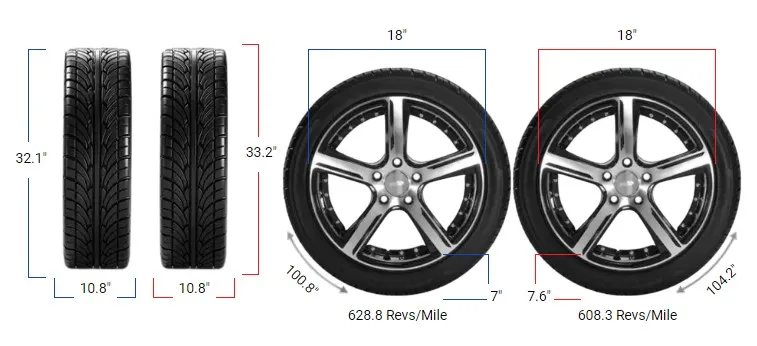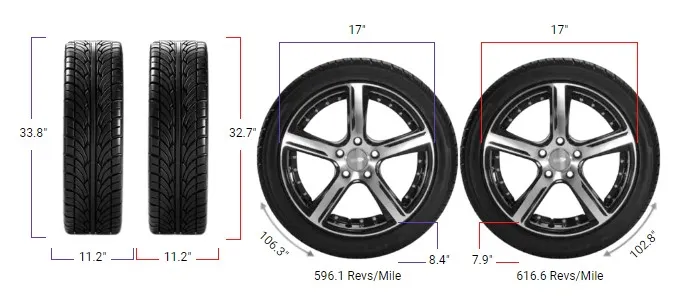Tire Size 225/65r17 vs 225/55r17

Are you considering switching from 225/65R17 to 225/55R17 tires? Before making the change, it’s important to understand how this difference will impact your vehicle’s performance on and off the road.
- The smaller tire diameter reduces ground clearance, making the vehicle sit lower.
- Lower sidewall height may result in a stiffer ride with less shock absorption.
- The vehicle may experience improved handling in sharp turns due to the smaller tires.
- Off-road performance could suffer due to increased vulnerability to scraping on rough terrain.
- The aesthetic look of the vehicle could shift toward a sportier appearance with the smaller tires.
- Fuel efficiency might slightly decrease at higher speeds due to the increased revolutions per mile.

Fitment Guide
It’s essential to stay within a 3% diameter difference from the original tire size. The difference between the 225/65R17 and 225/55R17 exceeds this range, coming in at -6.2%, making this swap not ideal without adjustments.
If you proceed with this switch, modifications like lifting or adjusting the suspension may be necessary to avoid rubbing or clearance issues.
On-Road Impact
Switching to 225/55R17 tires can noticeably affect your vehicle’s performance on regular roads. Here’s how the key factors come into play:

- Ground Clearance: The reduced tire diameter means your vehicle will sit slightly lower to the ground, decreasing its ground clearance by 0.89 inches (22.5 mm). This can affect how you drive over speed bumps or uneven surfaces, and your undercarriage may be more exposed to scrapes and damage.
- Gas Mileage: A smaller tire diameter reduces the overall circumference of the tire, meaning the engine has to work a little harder at higher speeds. While the change in fuel economy may be minimal, it could result in a slight decrease in gas mileage, especially on highways.
- Aesthetics Look: From an aesthetic standpoint, smaller tires can give your vehicle a sleeker appearance. However, the lowered stance may not appeal to those who prefer the rugged or bulky look of larger tires like 225/65R17.
- Ride Comfort: The sidewall height difference is -0.89 inches (22.5 mm), meaning the tire’s cushioning ability is reduced. A shorter sidewall often leads to a stiffer ride, as there is less rubber to absorb shocks from potholes and uneven surfaces. This may lead to a less comfortable ride on city roads.
- Speedometer Accuracy: Your speedometer is calibrated for the stock tire size. Switching to 225/55R17 will cause a speedometer reading discrepancy of around 6.6%. For example, when your speedometer shows 20 mph, your actual speed would be closer to 18.76 mph. This difference could become more significant at higher speeds and might even get you pulled over if you’re not careful.
Off-Road Impact
When driving off-road, tire size plays a critical role in traction, durability, and handling. With 225/55R17, you’ll see several off-road performance changes:

- Ground Clearance: Off-roading often requires high ground clearance to navigate uneven terrains, and the lower profile of the 225/55R17 reduces this by nearly an inch. This makes the vehicle more vulnerable to scraping on rocks or rough trails.
- Durability & Wear: The shorter sidewall not only impacts ride comfort but also off-road durability. A shorter sidewall increases the risk of damage from punctures or blowouts when hitting sharp objects or rocks. 225/65R17 tires with their taller sidewall provide more buffer in these rough conditions.
- Handling & Stability: On off-road terrains, handling and stability may suffer as the vehicle sits lower, and the 225/55R17 tires may not offer the same grip as the larger 225/65R17 tires. This could make driving on rocky or muddy paths more challenging.
225/65r17 vs 225/55r17
| Feature | 225/65R17 | 225/55R17 | Difference |
|---|---|---|---|
| Diameter inches (mm) | 28.52 (724.3) | 26.74 (679.3) | -1.77 (-45) -6.2% |
| Width inches (mm) | 8.86 (225) | 8.86 (225) | 0 (0) 0% |
| Circumference inches (mm) | 89.58 (2275.46) | 84.02 (2134.08) | -5.57 (-141.37) -6.2% |
| Sidewall Height inches (mm) | 5.76 (146.25) | 4.87 (123.75) | -0.89 (-22.5) -15.4% |
| Revolutions per mile (km) | 707.26 (439.47) | 754.11 (468.58) | 46.85 (29.11) 6.6% |
| Speedo Reading | 20 mph (32.19 km/h) | 18.76 mph (30.19 km/h) | -1.24 mph |
Difference Between 225/65r17 and 225/55r17
The main difference between 225/65R17 and 225/55R17 tires is their diameter. The 225/65R17 tire is 1.77 inches taller, which affects ground clearance, ride comfort, and handling.
Can I Use 225/55r17 Instead of 225/65r17?
Yes, you can use 225/55R17 instead of 225/65R17, but the size difference exceeds the recommended 3% range, which could affect speedometer accuracy and ride comfort without necessary modifications.
How Much Taller Is a 225/65r17 Tire Than a 225/55r17?
A 225/65R17 tire is approximately 1.77 inches taller than a 225/55R17 tire. This difference impacts ground clearance and may affect handling, especially on uneven surfaces.
Our Observation
Switching from 225/65R17 to 225/55R17 can lead to significant differences in both on-road and off-road performance.
On-road, the lower ground clearance, stiffer ride, and speedometer inaccuracy could negatively affect daily driving comfort, especially for those who value a smooth, cushioned ride.
Off-road, the reduction in ground clearance and increased risk of tire damage due to the shorter sidewalls are substantial downsides.
However, the change can provide a sleeker look, and the smaller tire size could improve handling in certain on-road scenarios like sharp turns. Ultimately, the decision to switch should depend on your driving preferences and needs, but the differences are far from negligible.



